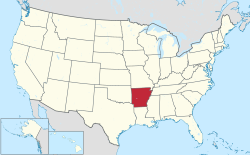|
United States of America – Commemorative Half Dollar
100th Anniversary of the Statehood of Arkansas
1937 D Silver 50 Cents (Half Dollar) 30.6mm (12.50 grams) 0.900 Silver (0.3617 oz. ASW) Denver mint
Reference: KM# 168 | Engraver: Edward Everett Burr, Emily Bates
Certification: PCGS MS 65 9242.65/9786759 | Mintage: 5,505
1836 1936 ARKANSAS CENTENNIAL, Liberty head and head of an American Indian looking to the left.
UNITED STATES OF AMERICA ARKANSAS IN GOD WE TRUST E PLURIBUS UNUM HALF DOLLAR 1937, Eagle with the Arkansas flag in the background.
This coin commemorated the 100th anniversary of the admission of Arkansas into the U.S. union as a state. An Indian Chief and an American girl were used as the portraits for the design on this coin.
You are bidding on the exact item pictured, provided with a Certificate of Authenticity and Lifetime Guarantee of Authenticity.
 Arkansas is a state in the southern region of the United States, home to over 3 million people as of 2018. Its name is of Siouan derivation from the language of the Osage denoting their related kin, the Quapaw Indians. The state’s diverse geography ranges from the mountainous regions of the Ozark and the Ouachita Mountains, which make up the U.S. Interior Highlands, to the densely forested land in the south known as the Arkansas Timberlands, to the eastern lowlands along the Mississippi River and the Arkansas Delta. Arkansas is a state in the southern region of the United States, home to over 3 million people as of 2018. Its name is of Siouan derivation from the language of the Osage denoting their related kin, the Quapaw Indians. The state’s diverse geography ranges from the mountainous regions of the Ozark and the Ouachita Mountains, which make up the U.S. Interior Highlands, to the densely forested land in the south known as the Arkansas Timberlands, to the eastern lowlands along the Mississippi River and the Arkansas Delta.
Arkansas is the 29th largest by area and the 33rd most populous of the 50 United States. The capital and most populous city is Little Rock, located in the central portion of the state, a hub for transportation, business, culture, and government. The northwestern corner of the state, such as the Fayetteville-Springdale-Rogers Metropolitan Area and Fort Smith metropolitan area, is a population, education, and economic center. The largest city in the state’s eastern part is Jonesboro. The largest city in the state’s southeastern part is Pine Bluff.

The Territory of Arkansas was admitted to the Union as the 25th state on June 15, 1836. In 1861, Arkansas withdrew from the United States and joined the Confederate States of America during the Civil War. On returning to the Union in 1868, the state continued to suffer due to its earlier reliance on slavery and the plantation economy, causing the state to fall behind economically and socially. White rural interests continued to dominate the state’s politics until the civil rights movement. Arkansas began to diversify its economy following World War II and relies on its service industry, aircraft, poultry, steel, tourism, cotton, and rice.
The culture of Arkansas is observable in museums, theaters, novels, television shows, restaurants, and athletic venues across the state. Arkansas’s enduring image has earned the state “a special place in the American consciousness”. People such as politician and educational advocate William Fulbright; former President Bill Clinton who served as the 40th and 42nd Governor of Arkansas; his wife, former Secretary of State Hillary Rodham Clinton; former NATO Supreme Allied Commander General Wesley Clark, Walmart magnate Sam Walton; singer-songwriters Johnny Cash, Charlie Rich, and Glen Campbell; the poet C. D. Wright; and physicist William L. McMillan, who was a pioneer in superconductor research; have all lived in Arkansas.
|








 Arkansas is a state in the southern region of the United States, home to over 3 million people as of 2018. Its name is of Siouan derivation from the language of the Osage denoting their related kin, the Quapaw Indians. The state’s diverse geography ranges from the mountainous regions of the Ozark and the Ouachita Mountains, which make up the U.S. Interior Highlands, to the densely forested land in the south known as the Arkansas Timberlands, to the eastern lowlands along the Mississippi River and the Arkansas Delta.
Arkansas is a state in the southern region of the United States, home to over 3 million people as of 2018. Its name is of Siouan derivation from the language of the Osage denoting their related kin, the Quapaw Indians. The state’s diverse geography ranges from the mountainous regions of the Ozark and the Ouachita Mountains, which make up the U.S. Interior Highlands, to the densely forested land in the south known as the Arkansas Timberlands, to the eastern lowlands along the Mississippi River and the Arkansas Delta. 





